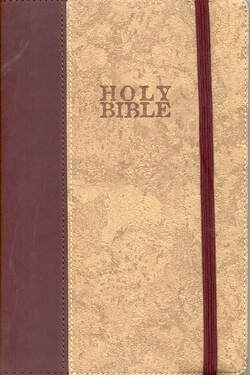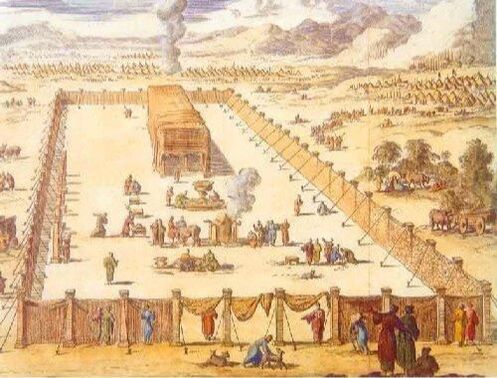Hebrews 9:1-12 Lesson 426
Read both the "King James Bible" and the "New Living Translation."
In this lesson:
Christ, the better sacrifice.
Worshipping under the Old Covenant (9:1-10).
The Lord's Tabernacle
(Public domain - copyright expired)
(Public domain - copyright expired)
What was -
The Tabernacle -
The Tabernacle was a sacred tent and sanctuary (Leviticus 12:4), and a "shadow of heavenly things"(Hebrews 8:5; 9:11; 9:24). It stood fifteen feet wide by forty-five feet long by fifteen feet high and was a place for Jews to worship and where the High Priest communed with God (Exodus 25:22). The Tabernacle was sometimes called "The house of the Lord" (Exodus 23:19; 34:26; Joshua 6:24); the "house of my God" (Joshua 9:23; Judges 18:31; 20:18), the "tabernacle of the congregation" (Exodus 29:42; 44; Numbers 17:4), the "tabernacle of testimony" (Exodus 38:21), "the Tabernacle of Witness (Numbers 17:7; 18:2), or the "Tent of Meeting." After escaping from Egyptian bondage, the Israelites built the Tabernacle, its altar, utensils, and furnishings based on God's instructions in Exodus 25:1-31:18. They carried it with them as they wandered in the wilderness. The Tabernacle housed the Ark of the Covenant and its contents (the Ten Commandments written with the finger of God (Exodus 31:18), Aaron's rod, and a golden pot of manna) for four hundred years until King Solomon built the Temple in Jerusalem. Inside, the tent (and later the Temple) was divided by a curtain into two rooms. The outer room was called "the holy place" and was open to all Jewish worshippers . The inner room was called "the most holy place," and only the High Priest (a descendant of Aaron) could enter. Once a year, on the Day of Atonement, the High Priest would enter "the most holy place" and offer a blood sacrifice to God (Exodus 30:10). This would atone for his sins and the sins of the people" as stipulated in Leviticus 16:6 and reinforced in Hebrews 5:2-3. When Christ died on the cross, the dividing curtain was torn in two (Matthew 27:50-51; Mark 15:37-38) to symbolize that the barrier between God and man had been removed. See Exodus 25:1-28:43 for more information on the Tabernacle and its contents.
Shewbread -
Holy or blessed bread. Every Sabbath, twelve loaves of unleavened bread (one for each tribe of Israel) were ceremoniously placed on the altar in the Holy Place of the Temple. They were an offering of thanks to God and could only be eaten by the priests at the end of the week (Exodus 29:32-33; Leviticus 24:5-9).
The Golden Censer -
The Golden Censer was the altar in the Tabernacle where a priest burned incense. The rising smoke from the burning incense carried prayers to God's ear (Exodus 30:1-10).
The Ark of the Covenant -
Also called the "Chest of the Covenant," the "Ark of the Testimony" (Exodus 26:33; 30:6; 30:26; 31:7), or the "Ark of his testament" (Revelation 11:19). The Ark was a wooden chest 3 3/4 feet long, 2 1/4 feet wide, 2 1/4 feet high made of wood and covered with gold (Exodus 25:10-16). It represented the presence of God and carried Jewish religious treasures such as the Ten Commandments (Deuteronomy 31:26), Aaron's wooden rod (Numbers 17:8-10), and a golden pot of manna (Exodus 16:32-34). Atop the chest was the Mercy Seat, made of solid gold. The Ark was kept in the Most Holy Place in the tabernacle (2 Chronicles 5:7; Hebrews 9:3-4), where only a High Priest descended from Aaron could enter. The Ark disappeared when the Babylonians conquered, looted, and destroyed Jerusalem.
The Tables of the Covenant -
The Tables of the Covenant were the two stone tablets God wrote the Ten Commandments on.
The Mercyseat -
The Mercyseat was the golden lid of the Ark of the Covenant. The lid was God's symbolic throne (1 Samuel 4:4; 2 Samuel 6:2) and adorned with "two cherubims of gold" on either end (Exodus 25:18). Annually, on the Day of Atonement, the High Priest made an offering to atone for sins by sprinkling sacrificial blood on the Mercyseat. To learn more, see Exodus 25:17-22.
The Tabernacle -
The Tabernacle was a sacred tent and sanctuary (Leviticus 12:4), and a "shadow of heavenly things"(Hebrews 8:5; 9:11; 9:24). It stood fifteen feet wide by forty-five feet long by fifteen feet high and was a place for Jews to worship and where the High Priest communed with God (Exodus 25:22). The Tabernacle was sometimes called "The house of the Lord" (Exodus 23:19; 34:26; Joshua 6:24); the "house of my God" (Joshua 9:23; Judges 18:31; 20:18), the "tabernacle of the congregation" (Exodus 29:42; 44; Numbers 17:4), the "tabernacle of testimony" (Exodus 38:21), "the Tabernacle of Witness (Numbers 17:7; 18:2), or the "Tent of Meeting." After escaping from Egyptian bondage, the Israelites built the Tabernacle, its altar, utensils, and furnishings based on God's instructions in Exodus 25:1-31:18. They carried it with them as they wandered in the wilderness. The Tabernacle housed the Ark of the Covenant and its contents (the Ten Commandments written with the finger of God (Exodus 31:18), Aaron's rod, and a golden pot of manna) for four hundred years until King Solomon built the Temple in Jerusalem. Inside, the tent (and later the Temple) was divided by a curtain into two rooms. The outer room was called "the holy place" and was open to all Jewish worshippers . The inner room was called "the most holy place," and only the High Priest (a descendant of Aaron) could enter. Once a year, on the Day of Atonement, the High Priest would enter "the most holy place" and offer a blood sacrifice to God (Exodus 30:10). This would atone for his sins and the sins of the people" as stipulated in Leviticus 16:6 and reinforced in Hebrews 5:2-3. When Christ died on the cross, the dividing curtain was torn in two (Matthew 27:50-51; Mark 15:37-38) to symbolize that the barrier between God and man had been removed. See Exodus 25:1-28:43 for more information on the Tabernacle and its contents.
Shewbread -
Holy or blessed bread. Every Sabbath, twelve loaves of unleavened bread (one for each tribe of Israel) were ceremoniously placed on the altar in the Holy Place of the Temple. They were an offering of thanks to God and could only be eaten by the priests at the end of the week (Exodus 29:32-33; Leviticus 24:5-9).
The Golden Censer -
The Golden Censer was the altar in the Tabernacle where a priest burned incense. The rising smoke from the burning incense carried prayers to God's ear (Exodus 30:1-10).
The Ark of the Covenant -
Also called the "Chest of the Covenant," the "Ark of the Testimony" (Exodus 26:33; 30:6; 30:26; 31:7), or the "Ark of his testament" (Revelation 11:19). The Ark was a wooden chest 3 3/4 feet long, 2 1/4 feet wide, 2 1/4 feet high made of wood and covered with gold (Exodus 25:10-16). It represented the presence of God and carried Jewish religious treasures such as the Ten Commandments (Deuteronomy 31:26), Aaron's wooden rod (Numbers 17:8-10), and a golden pot of manna (Exodus 16:32-34). Atop the chest was the Mercy Seat, made of solid gold. The Ark was kept in the Most Holy Place in the tabernacle (2 Chronicles 5:7; Hebrews 9:3-4), where only a High Priest descended from Aaron could enter. The Ark disappeared when the Babylonians conquered, looted, and destroyed Jerusalem.
The Tables of the Covenant -
The Tables of the Covenant were the two stone tablets God wrote the Ten Commandments on.
The Mercyseat -
The Mercyseat was the golden lid of the Ark of the Covenant. The lid was God's symbolic throne (1 Samuel 4:4; 2 Samuel 6:2) and adorned with "two cherubims of gold" on either end (Exodus 25:18). Annually, on the Day of Atonement, the High Priest made an offering to atone for sins by sprinkling sacrificial blood on the Mercyseat. To learn more, see Exodus 25:17-22.
Study Tip:
The more we know about the Old Testament, the more we understand the New Testament.
Always click on the links to Old Testament passages.
They are a vital tool that helps us understand God's plan.
The more we know about the Old Testament, the more we understand the New Testament.
Always click on the links to Old Testament passages.
They are a vital tool that helps us understand God's plan.











